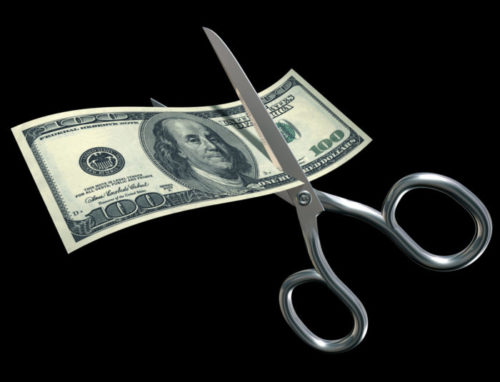The government applies different types of tax cuts, depending on the economic situation. Some cuts focus on businesses, corporations, or investors, while others are for individual consumers.
All tax cuts have two things in common. First, the government changes the law or tax code to lower taxes for the target area. Second, the government provides tax cuts to incentivize a specific activity that will benefit the economy or serve a particular purpose.
For example, the government may temporarily cut income taxes to provide individuals with more disposable income. The hope is that they will spend this income and, in doing so, stimulate the economy.
In addition to federal tax cuts, a state can also cut taxes. For example, a state could lower corporate taxes to draw new companies who, the government hopes, will employ residents.
Table of Contents
Tax Cut Definition
A tax cut is a change to tax laws that lowers the amount of money you have to pay in taxes.
Tax cuts can take several different forms. However, regardless of the details, all tax cuts mean that you effectively pay fewer taxes.
Some tax cuts involve lowering the overall tax rate for an individual or a business. For example, a tax cut may reduce the percentage of income that taxpayers in a specific income tax bracket have to pay.
Some tax cuts come in the form of rebates. These tax cuts are temporary, and the government offers them to stimulate spending in general or in a specific area, such as renewable energy or education.
Some tax breaks are usually for a very specific purpose, such as raising a child. To get these tax breaks, you need to prove that you meet the requirements to claim specific tax credits or deductions.
Types of Tax Cuts
All tax cuts change existing tax law. The result of this change is that an individual, family, organization, or business entity pays less money in taxes.
Income Tax Cuts
Income tax cuts lower the amount that individual taxpayers have to pay on their income. The goal of most income tax cuts is to increase spending at the consumer level. Consumer spending is an integral part of the economy, so providing income tax cuts can help improve the economy.
In some instances, income tax cuts are rebates or one-time cuts that stimulate the economy during a recession or economic downturn. Income tax revenue makes up approximately half of federal tax revenue, so an income tax cut can have a significant impact on the economy. Ideally, the tax cuts will pay for themselves because a healthier economy will eventually lead to more taxable income for individuals and businesses.
One of the more recent income tax cuts was the 2017 Tax Cuts and Jobs Act. The tax law changes in this instance included higher deductions, a higher child tax credit, and a credit for other non-child dependents. If you met the criteria to qualify for these deductions and credits, your tax burden was effectively lower.
In some cases, a state may institute a flat tax rate. This move could be a tax cut for some people who paid a higher rate in a tiered tax system.
Inheritance and Estate Tax Cuts
Income and estate tax cuts lower the amount that beneficiaries have to pay in taxes when they inherit an estate. Some states and the federal government charge estate taxes.
The Tax Cuts and Jobs Act increased the exemption levels for estate taxes. This increase is a tax cut because people can inherit more money without paying taxes on it. The exemption was $5.5 million in 2017, but it increased to more than $11 million in 2019.
This inheritance tax cut is an example of a temporary tax cut. The cut expires in 2025, and the inheritance tax rate will return to 2017 levels, but it will get adjusted slightly for inflation.
Capital Gains Tax Cuts
Capital gains tax cuts lower the amount of taxes that you have to pay on the return on some investments. Capital gains taxes get applied to certain assets that you sell for a profit. You pay a percentage of your profit in taxes. A capital gains tax cut would lower that percentage.
Capital gains taxes are a small component of the federal government’s tax revenue. However, in the past, the government has cut the tax rate for long-term capital gains, which are the profits on assets that you have held for more than one year.
Significant capital gains tax cuts occurred in 2003 when the tax rate on long-term capital gains went from 20% to 15% and from 10% to 5% for the lowest income tax bracket.
Business Tax Cuts
Business tax cuts lower the taxes that businesses have to pay on their profits. These taxes can vary depending on the size of the business. Some cuts are for all businesses, but others are only for small businesses or large corporations. Corporations may have a different tax rate than smaller companies.
Often, the government offers tax cuts to businesses as an incentive to hire more workers and expand their operations, which can help employment rates and improve important economic metrics such as the gross domestic product (GDP).
Businesses can also qualify for payroll tax breaks, which lower the amount of money that they need to contribute to Social Security and Medicare.
Businesses can also earn specific tax cuts by taking advantage of tax credits that provide incentives for them to do specific things. Recent examples of such tax credits include credits for using renewable energy.
One of the most significant recent tax cuts, following the 2008 financial crisis, helped businesses retain or hire employees. The goal of these cuts was to lower the overall unemployment rate by incentivizing companies to hire new employees or keep current employees.
Temporary Tax Cuts
Some tax cuts are temporary. These cuts stimulate the economy or meet some other economic goals. However, the objective is short term, so the cuts expire after one year or several years.
Some rebates and credits get scheduled to end after a few years, but they can get renewed by Congress before they expire.
For example, many of the tax cuts in the 2017 Tax Cuts and Jobs Act will eventually expire. The temporary nature of these cuts allows the government to renew those that produce economic growth and end those that did not deliver the desired results.
Benefits of Tax Cuts
Tax cuts can benefit taxpayers and, ideally, stimulate the economy and provide incentives for people to take specific actions.
Businesses may retain more of their profits after tax cuts, which will satisfy their shareholders or owners. However, they may also hire new employees or develop their business to provide more jobs in the future. So business tax cuts can lead to lower unemployment rates.
The benefits to individual taxpayers include having more disposable income or working fewer hours to meet their financial obligations. With some tax cuts, such as those related to children or dependents, the taxpayer may have an easier time caring for their family because of the tax credits.
The government loses revenue when they make tax cuts, but they hope that the money will get replaced in the future because people and businesses will have more income to spend. The government may create other taxes to balance its budget at a later time.
In some cases, tax cuts bring about a specific benefit. For example, when the government wants more people to use renewable energy, they offer a rebate to those who install renewable energy in a home or business. The result of this tax cut could be that more people use renewable energy.
How Tax Cuts Work to Stimulate the Economy
Tax cuts can stimulate spending. This increased revenue may be difficult to see. At the macroeconomic level, governments look at figures such as the GDP.
Consumer spending makes up a large part of the GDP, so if each person in the country has even a little bit more money to spend, the GDP can increase significantly. This increase can affect businesses that produce goods and services for consumers.
Business tax cuts may have a similar impact on spending and GDP. Also, businesses may hire more workers. These new employees will have more income to spend to improve the economy further.
Image Source: https://depositphotos.com/





